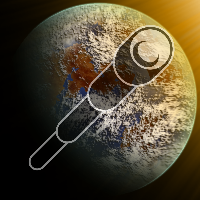Star
Stars are one of the most important objects in the Yonderverse due to their power in supporting massive amounts of life. Stars are only found in Aavar's River, along massive leylines that distribute magic and energy. These supermassive luminous balls of plasma produce their own gravity, tethering other celestial objects in its orbit.
Anatomy of a Star

A star, simply put, is a ball of hot gases, plasma, and souls. Creating the gravity of a star is a frozen ball of souls in the very core. Typically, the number of souls in a star's core directly corresponds to its size and the strength of its gravity. More souls in the core tends to result in a larger, heavier star.
Surrounding this core are gases and plasma - mostly hydrogen, some helium, and small amounts of other elements. Reactions between these elements produces stardust, a valuable material with many variants. The superheated gases have electrons removed, forming plasma. Plasma makes up the majority of a star.
Star Life Cycle
Stellar Classification
Did you know? There are roughly 3.9x1058 stars in Aavar's River, with an average of 6 planets in each System!
The colour of a star depends on several factors, including its temperature and composition.
As the temperature of a star increases, radiated energy increases. Stars emit light across the electromagnetic spectrum, and a hotter star emits light on shorter wavelengths, producing a red colour. Colder stars emit light on longer wavelengths, producing a more blue colour.
The number of souls in a star influences its temperature as well. A soul can alter where light is emitted on the spectrum, so a 32,000K star may not appear blue, if it has an unusual amount of souls.
| Class | Temperature | Colour |
|---|---|---|
| X | > 100,000 K | |
| P | 45,000 K - 100,000 K | |
| O | 33,000 - 45,000 K | |
| B | 10,000 - 33,000 K | |
| A | 7,300 - 10,000 K | |
| F | 6,000 - 7,300 K | |
| G | 5,300 - 6,000 K | |
| K | 3,900 - 5,300 K | |
| M | 2,300 - 3,900 K | |
| L | 1,600 - 2,300 K | |
| T | 1,000 - 1,600 K | |
| Y | 500 - 1,000 K |
Cultural Significance
Ever since the first sophonts appeared close to Aavar's River, 290 billion years ago, these celestial wonders have been a revered part of culture and life itself. In prehistoric and modern cultures stars are often seen as precious objects or powerful deities.
Stars often play an important role in religion. Stars, worshipped as deities, are often associated with enlightenment, divinity, and benevolence.
Stars playing a role in culture has become more prevalent in recent years. A famous theatrical play named Joy in Isolation, debuting in the Griez Space Station a thousand years ago, depicts a lone star as a childlike figure seeking friends. It articulates the vastness of space in an urban setting. This play kicked off the role of stars in media and film, popular within the Milky Way.
Stars are all too common in traditional art. There is often a depicted similarity between a star and the mind, and how vast both are and the spaces they inhabit. A star is a simple part of the Yonderverse as a whole, just as the mind has barely been explored and understood.
Ecology
Despite such extreme temperatures, life thrives within the confines of stars. These organisms are highly adapted to deal with extraordinary climates. Species such as gold gobblers and sunfins survive by drinking rivers of liquid gold in hotter stars. Others survive through their innate connection with various forms of magic, such as pyromancy and stellamancy.
Slaughter of the Suns
A severe threat to stars are sun spiders. These massive arachnids burrow into just one star in their life, laying one egg in the star's core, before collapsing and succumbing to the boiling environments. The baby spider will hatch and spend its entire life consuming the star until it collapses. Energy from the star keeps it alive for however long it takes for the star to be destroyed.
Once the star collapses, the spider enters a dormant state and floats through space until it lands on another star, and the life cycle continues.










Ooo I like star spiders! Unsettling.
Thank youuu! They creep me ouuut, I can't wait to draw them